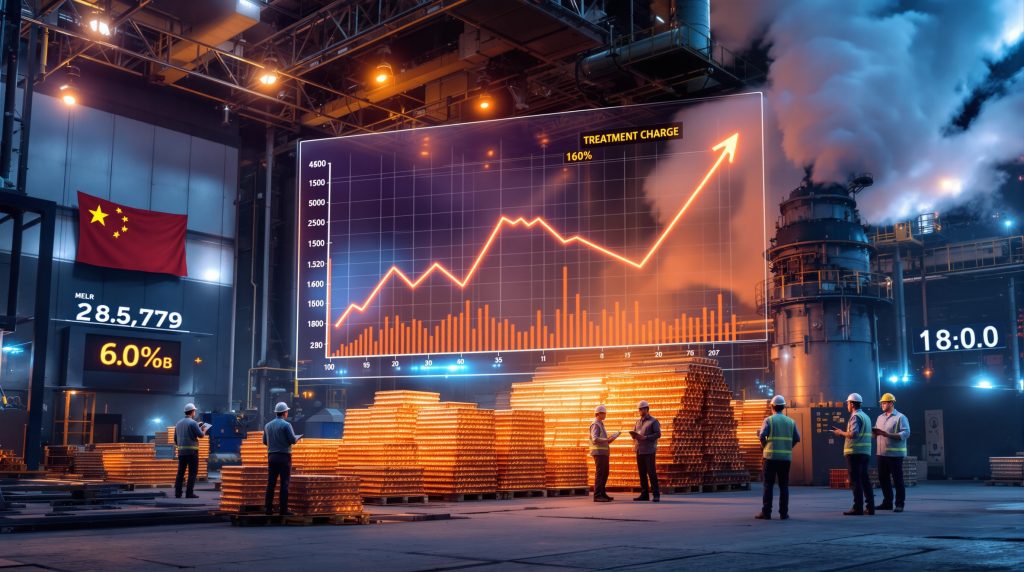Why Is China's Copper Output Declining From Record Highs?
China's refined copper output dropped to 1.27 million tons in July 2025, decreasing from the record high of 1.3 million tons achieved in June. This decline marks a significant turning point in the country's copper production trajectory, which had been setting successive records throughout early 2025 despite challenging market conditions.
The production decline comes amid broader economic pressures and government initiatives to address industrial overcapacity, suggesting a potential structural shift in China's copper industry rather than a temporary fluctuation. The implications of this shift could significantly affect copper price predictions throughout global markets.
What's Driving China's Copper Production Pullback?
Government Overcapacity Crackdown
Beijing has intensified its campaign against excess output and market gluts across multiple sectors. While industries like steel and solar have faced stricter regulations, the copper industry has received more lenient treatment due to its strategic importance.
"The copper industry has been granted more leniency due to its strategic role in high-tech and clean energy manufacturing," reported Bloomberg News on August 19, 2025.
This strategic importance centers around copper's critical role in:
- Electric vehicle production and charging infrastructure
- Renewable energy systems including solar and wind power
- Advanced electronics and telecommunications infrastructure
- Power grid modernization initiatives
Despite this preferential status, copper smelters are now feeling the effects of Beijing's broader industrial consolidation efforts as the government balances strategic needs with economic realities.
Economic Pressures on Smelters
Negative Treatment Charges
Chinese copper smelters face significant profitability challenges due to deteriorating market conditions. Industry data shows spot treatment charges (TCs) for processing copper concentrate have fallen below zero, creating an unsustainable business model for many producers.
"Spot treatment charges to process ore into metal are still well below zero, squeezing margins for smelters and pushing some to the brink of closing down," according to Mining.com.
This pricing dynamic represents a fundamental reversal of the traditional smelter business model:
- Traditional model: Miners pay smelters a TC/RC fee to process concentrate
- Current situation: Smelters must pay miners to secure concentrate supply
- Result: Severely compressed profit margins approaching shutdown thresholds
Raw Material Supply Constraints
The tightening feedstock market has created additional pressure on Chinese copper smelters. Competition for copper concentrate has intensified globally, with China particularly vulnerable due to its heavy reliance on imported materials.
Factors contributing to raw material constraints include:
- Limited new mine development globally in recent years
- Logistical challenges affecting international shipping and supply chains
- Increased competition from smelters in other regions
- Political tensions affecting trade relationships with key supplier nations
How Does This Impact Global Copper Markets?
Price Implications
Despite the production decline in China, copper prices showed minimal immediate movement. Following the release of the production data, copper rose just 0.1% to $9,745 per ton on the London Metal Exchange. In comparison, aluminum dropped 0.7% and nickel fell 0.3% during the same period.
This muted price response suggests several possibilities:
- The market had already anticipated some production adjustment
- Traders are waiting for confirmation of a sustained trend rather than reacting to a single month's data
- Other factors may be counterbalancing the supply implications of reduced Chinese output
- Inventory levels may be sufficient to absorb short-term production fluctuations
Market analysts note that while a single month's decline doesn't necessarily indicate a long-term trend, continued production decreases could eventually lead to more significant price responses, particularly when considered alongside the global copper supply forecast for coming years.
Strategic Significance of Chinese Copper Production
China's copper industry holds particular importance in global markets as the country represents both the world's largest producer and consumer of refined copper. Any shift in Chinese production capacity has ripple effects throughout global supply chains.
The strategic importance of Chinese copper production includes:
- Setting global benchmark prices through purchasing patterns
- Influencing mining investment decisions worldwide
- Affecting treatment and refining charge negotiations globally
- Signaling broader economic trends and industrial policy directions
Historical Context of China's Copper Production
Record-Setting Production Trend
Prior to the July decline, Chinese copper output had been on a remarkable growth trajectory, with Bloomberg News noting "a succession of record production figures this year" despite challenging market conditions.
This consistent production growth occurred despite:
- Deteriorating treatment charges reaching negative territory
- Rising energy costs affecting operational expenses
- Environmental compliance requirements becoming more stringent
- Slowing growth in domestic construction and property sectors
The persistence of output growth despite these headwinds demonstrates both the strategic importance of copper to China's industrial policy and the country's determination to maintain self-sufficiency in critical materials.
Industrial Policy Shift
The production decline coincides with a broader pivot in Chinese industrial policy. After decades of rapid industrialization focused primarily on quantity and growth metrics, Beijing has increasingly emphasized:
- Higher quality development with reduced environmental impact
- Consolidation of fragmented industries into stronger national champions
- Rationalization of capacity to improve efficiency and global competitiveness
- Strategic self-sufficiency in critical materials and technologies
This policy evolution has led to targeted interventions across multiple industrial sectors, with copper now showing signs of being included in these broader efforts.
What Are The Implications For Copper Supply Chains?
Potential Market Rebalancing
The production pullback could trigger several market adjustments if sustained over multiple months:
- Treatment charge recovery: Reduced demand for concentrate could ease the negative TC situation
- Smelter consolidation: Smaller, less efficient operations may be forced to close or merge
- Supply discipline: Overall market balance could improve if production better matches demand
- Inventory normalization: Stocks-to-consumption ratios may stabilize after recent volatility
Global Supply Considerations
China's production trends will impact worldwide copper availability, particularly as the global energy transition increases rising copper demand for the metal in clean energy applications.
Key considerations for global supply include:
- Regional production shifts: Other copper-producing regions may increase output to fill any gap
- Project development timelines: New mining projects typically require 5-10 years from discovery to production
- Recycling incentives: Higher prices could accelerate copper recycling and secondary production
- Substitution effects: Extreme price movements might accelerate material substitution in some applications
How Might China's Copper Industry Evolve?
Strategic Versus Economic Priorities
The Chinese government faces competing objectives in managing the copper sector:
| Strategic Priorities | Economic Realities |
|---|---|
| Ensure sufficient supply for high-tech manufacturing | Address overcapacity and inefficiency |
| Maintain self-sufficiency in critical materials | Improve return on capital and profitability |
| Support clean energy transition | Reduce environmental impacts |
| Build global competitive advantage | Rationalize struggling operations |
Balancing these priorities will likely shape policy decisions regarding production quotas, environmental regulations, merger approvals, and international trade positions.
Consolidation Possibilities
Industry restructuring may accelerate if current conditions persist, following patterns seen in other Chinese industrial sectors such as steel and coal. Potential consolidation scenarios include:
- Government-supported mergers among major producers
- Acquisition of struggling smaller players by state-owned enterprises
- Coordinated capacity rationalization through industry associations
- Preferential resource allocation to designated national champions
"The data mark a potential turning point for the country's copper smelters," noted Bloomberg News, suggesting industry observers should watch closely for signs of structural change beyond monthly production fluctuations.
FAQ: China's Copper Production Trends
Why is copper considered a strategic metal in China?
Copper plays a crucial role in China's economic development as an essential component in:
- Electrical grid infrastructure and power transmission
- Renewable energy systems including solar, wind, and hydropower
- Electric vehicle production and charging networks
- Advanced manufacturing and electronics
- Defense and telecommunications applications
Its versatility, conductivity, and lack of practical substitutes in many applications make copper particularly strategic for China's industrial modernization and technological advancement goals.
How do negative treatment charges affect copper smelters?
Negative treatment charges fundamentally disrupt the traditional smelter business model:
- Traditionally, smelters receive fees from miners for processing concentrate into refined metal
- Under negative TCs, this relationship reverses – smelters must pay miners to secure material
- This payment structure severely impacts profitability and cash flow
- Smaller or less efficient operations face unsustainable economics
- Even larger operations see margins compressed to potentially unsustainable levels
This pricing dynamic indicates a significant imbalance between smelting capacity and concentrate availability.
What other industrial sectors in China are facing overcapacity concerns?
Beyond copper, the Chinese government has targeted overcapacity in numerous heavy industries:
- Steel production (particularly lower-grade construction steel)
- Aluminum smelting and processing
- Cement manufacturing
- Glass production
- Solar panel manufacturing
- Coal mining and power generation
- Shipbuilding and heavy equipment manufacturing
These efforts reflect China's broader transition from quantity-focused growth to quality-focused development.
How might this production decline affect global copper prices long-term?
If Chinese production continues to decrease while global demand remains strong, several price scenarios become possible:
- Short-term volatility: Markets may experience price spikes during adjustment periods
- Medium-term rationalization: Supply-demand balance could improve if capacity adjustments are orderly
- Long-term investment cycle: Higher prices could eventually stimulate new mining investment
- Substitution effects: Extreme price movements might accelerate material alternatives in some applications
The clean energy transition represents a particularly important demand factor, as renewable energy systems require significantly more copper than traditional power generation. This transition is prompting many investors to explore various copper investment strategies to capitalize on the changing market dynamics.
Future Outlook for China's Copper Industry
The July production decline may represent the beginning of a structural shift in China's copper industry rather than a temporary fluctuation. While a single month's data doesn't establish a trend, the combination of government policy signals and economic pressures suggests meaningful change is underway.
Several factors will influence the industry's trajectory in coming months:
- Government policy implementation regarding industrial overcapacity
- Evolution of treatment charges and concentrate availability
- Energy costs and environmental compliance requirements
- Downstream demand from manufacturing and construction sectors
- Global trade dynamics affecting copper concentrate flows
The strategic importance of copper in China's industrial ecosystem suggests that while rationalization may continue, the government will likely seek to maintain sufficient production capacity to support national priorities in technology and clean energy development.
China's approach to balancing these competing priorities will shape not only domestic copper markets but global supply chains and pricing for this critical industrial metal. Additionally, this shifting landscape is creating interesting opportunities in the copper-uranium investment outlook as resource companies diversify their portfolios to manage risk in an evolving market.
Are You Tracking the Next Major Mineral Discovery?
Stay ahead of the market with Discovery Alert's proprietary Discovery IQ model, which instantly notifies investors of significant ASX mineral discoveries like potential new copper finds. Explore why major mineral discoveries can lead to substantial returns by visiting Discovery Alert's dedicated discoveries page.




